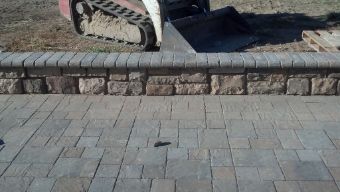Corona Concrete Pavers

When people see bricks, the common assumption they have is that they are made of clay. This isn’t always the case. While paving bricks are made of clay, concrete pavers that look like the traditional bricks are made of an entirely different material. Concrete pavers are usually made of cement combined with aggregate. They are usually created in molds. They are then taken through a vibration process that provides them with density. With time, these units get stronger as a result of the hardening and curing of cement.
You can reach out to Corona Concrete And Masonry at (951) 482-7781 for more information about concrete pavers in Corona. We also offer free estimates.
Coloring of Concrete Pavers
Since it isn’t inherent to the material, any pigment that is added to the concrete pavers can wear off exposing the aggregate’s color. This can also result in the concrete paver changing its original color. The dark pigments will fade with time. Unfortunately, after the color fading, it can be hard to restore the color to its original look without changing the concrete pavers. Like it is the case with the modern extruded brick pavers, an accurate dimension is used to make concrete pavers.
Paver Options
One of the options of concrete pavers is mortarless interlocking pavers that are available in different shapes, sizes, and colors. These machines made materials have high strength making them a suitable option for walkway, driveway, and patio floors. When concrete pavers are laid on a base made with fine sand and gravel, they can offer a flat and elegant patio surface.
While mortar isn’t required to assemble them, they can be installed in a thin bed of sand, creating a strong interlock. In such an instance, sand is usually vibrated between the different paver joints.
Pros and Cons of Concrete Pavers Over Bricks
Many homeowners prefer concrete pavers over the natural bricks for several reasons. They are a great choice for patio, wall, stairs, fireplaces, and driveways. Here are their pros and cons.
Pros
- Cost-effective. As compared to a brick, concrete is cheaper because of the inexpensive material used.
- Variety. Like we have already seen, stone and concrete have a wider range regarding size and color.
- Installation. Concrete pavers are easier to cut and install
- Innovation. Since concrete pavers are inexpensive, there are improvements’ being made every day. Newer pavers are being created, ensuring a wide range of design options.
Cons
- Color. Color pigments are used to produce color in concrete pavers. This color will begin to fade after someone, especially when exposed to sunlight.
- Erosion. Brick pavers crack and chip easily. However, concrete will wear out gradually. After someone, their smooth finish will disappear, exposing the underneath composite.
- Nondurable. Concrete pavers don’t last as long as brick pavers as they erode with time.
- Sealing. Concrete pavers have a very delicate nature, raising the need to use sealant solutions. This can increase its maintenance cost.
If you are trying to determine if you need to use a brick or concrete paver for your project, you should speak to a masonry contractor.
You can reach out to Corona Concrete And Masonry on (951) 482-7781 for free advice
